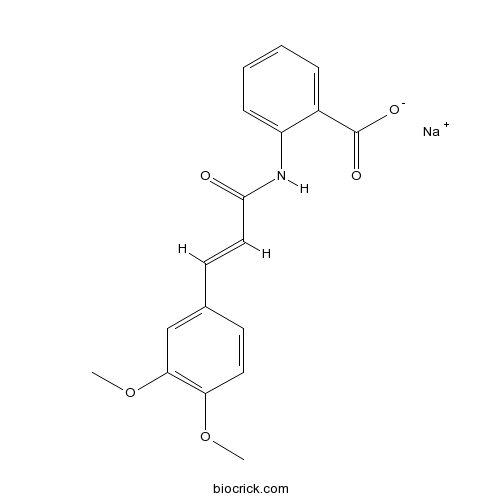Tranilast SodiumAntiallergic agent CAS# 104931-56-8 |

- U0126-EtOH
Catalog No.:BCC1066
CAS No.:1173097-76-1
- Pimasertib (AS-703026)
Catalog No.:BCC2529
CAS No.:1236699-92-5
- PD98059
Catalog No.:BCC1098
CAS No.:167869-21-8
- SL-327
Catalog No.:BCC1123
CAS No.:305350-87-2
- MEK162 (ARRY-162, ARRY-438162)
Catalog No.:BCC1148
CAS No.:606143-89-9
- Refametinib
Catalog No.:BCC4276
CAS No.:923032-37-5
Quality Control & MSDS
3D structure
Package In Stock
Number of papers citing our products

| Cas No. | 104931-56-8 | SDF | Download SDF |
| PubChem ID | 23669590 | Appearance | Powder |
| Formula | C18H16NNaO5 | M.Wt | 349.31 |
| Type of Compound | N/A | Storage | Desiccate at -20°C |
| Solubility | Soluble in DMSO | ||
| Chemical Name | sodium;2-[[(E)-3-(3,4-dimethoxyphenyl)prop-2-enoyl]amino]benzoate | ||
| SMILES | COC1=C(C=C(C=C1)C=CC(=O)NC2=CC=CC=C2C(=O)[O-])OC.[Na+] | ||
| Standard InChIKey | KZGHWWBBHZLTTA-VRTOBVRTSA-M | ||
| Standard InChI | InChI=1S/C18H17NO5.Na/c1-23-15-9-7-12(11-16(15)24-2)8-10-17(20)19-14-6-4-3-5-13(14)18(21)22;/h3-11H,1-2H3,(H,19,20)(H,21,22);/q;+1/p-1/b10-8+; | ||
| General tips | For obtaining a higher solubility , please warm the tube at 37 ℃ and shake it in the ultrasonic bath for a while.Stock solution can be stored below -20℃ for several months. We recommend that you prepare and use the solution on the same day. However, if the test schedule requires, the stock solutions can be prepared in advance, and the stock solution must be sealed and stored below -20℃. In general, the stock solution can be kept for several months. Before use, we recommend that you leave the vial at room temperature for at least an hour before opening it. |
||
| About Packaging | 1. The packaging of the product may be reversed during transportation, cause the high purity compounds to adhere to the neck or cap of the vial.Take the vail out of its packaging and shake gently until the compounds fall to the bottom of the vial. 2. For liquid products, please centrifuge at 500xg to gather the liquid to the bottom of the vial. 3. Try to avoid loss or contamination during the experiment. |
||
| Shipping Condition | Packaging according to customer requirements(5mg, 10mg, 20mg and more). Ship via FedEx, DHL, UPS, EMS or other couriers with RT, or blue ice upon request. | ||

Tranilast Sodium Dilution Calculator

Tranilast Sodium Molarity Calculator
| 1 mg | 5 mg | 10 mg | 20 mg | 25 mg | |
| 1 mM | 2.8628 mL | 14.3139 mL | 28.6279 mL | 57.2557 mL | 71.5697 mL |
| 5 mM | 0.5726 mL | 2.8628 mL | 5.7256 mL | 11.4511 mL | 14.3139 mL |
| 10 mM | 0.2863 mL | 1.4314 mL | 2.8628 mL | 5.7256 mL | 7.157 mL |
| 50 mM | 0.0573 mL | 0.2863 mL | 0.5726 mL | 1.1451 mL | 1.4314 mL |
| 100 mM | 0.0286 mL | 0.1431 mL | 0.2863 mL | 0.5726 mL | 0.7157 mL |
| * Note: If you are in the process of experiment, it's necessary to make the dilution ratios of the samples. The dilution data above is only for reference. Normally, it's can get a better solubility within lower of Concentrations. | |||||

Calcutta University

University of Minnesota

University of Maryland School of Medicine

University of Illinois at Chicago

The Ohio State University

University of Zurich

Harvard University

Colorado State University

Auburn University

Yale University

Worcester Polytechnic Institute

Washington State University

Stanford University

University of Leipzig

Universidade da Beira Interior

The Institute of Cancer Research

Heidelberg University

University of Amsterdam

University of Auckland

TsingHua University

The University of Michigan

Miami University

DRURY University

Jilin University

Fudan University

Wuhan University

Sun Yat-sen University

Universite de Paris

Deemed University

Auckland University

The University of Tokyo

Korea University
Tranilast has been approved in Japan and South Korea, since 1982, for the treatment of bronchial asthma, with indications for keloids and hypertrophic scar added in 1993. Tranilast is also used to treat asthma, autoimmune diseases, atopic and fibrotic pat
- Borapetoside B
Catalog No.:BCN6593
CAS No.:104901-05-5
- dl-Aloesol
Catalog No.:BCN7265
CAS No.:104871-04-7
- (+)-Isopulegol
Catalog No.:BCN4975
CAS No.:104870-56-6
- NF 023
Catalog No.:BCC6985
CAS No.:104869-31-0
- NF 157
Catalog No.:BCC7367
CAS No.:104869-26-3
- UPF 1069
Catalog No.:BCC2213
CAS No.:1048371-03-4
- Germanicol acetate
Catalog No.:BCN7264
CAS No.:10483-91-7
- Alpha-Terpineol
Catalog No.:BCN8136
CAS No.:10482-56-1
- COR 170
Catalog No.:BCC6282
CAS No.:1048039-15-1
- Masitinib mesylate
Catalog No.:BCC1729
CAS No.:1048007-93-7
- MRS 2768 tetrasodium salt
Catalog No.:BCC7800
CAS No.:1047980-83-5
- 4-O-Methylsappanol
Catalog No.:BCN5863
CAS No.:104778-16-7
- H-D-Val-OtBu.HCl
Catalog No.:BCC3146
CAS No.:104944-18-5
- Ethyl β-D-ribo-hex-3-ulopyranoside
Catalog No.:BCC8977
CAS No.:104953-08-4
- 8-Hydroxydigitoxigenin
Catalog No.:BCN5864
CAS No.:1049674-06-7
- Naspm trihydrochloride
Catalog No.:BCC7476
CAS No.:1049731-36-3
- A 331440 dihydrochloride
Catalog No.:BCC7963
CAS No.:1049740-32-0
- Cardiogenol C hydrochloride
Catalog No.:BCC7790
CAS No.:1049741-55-0
- PS 1145 dihydrochloride
Catalog No.:BCC7949
CAS No.:1049743-58-9
- 3-Acetoxy-4,7(11)-cadinadien-8-one
Catalog No.:BCN5865
CAS No.:104975-02-2
- Tacrolimus (FK506)
Catalog No.:BCC4952
CAS No.:104987-11-3
- Ascomycin(FK 520)
Catalog No.:BCC1370
CAS No.:104987-12-4
- Pallidol
Catalog No.:BCN3306
CAS No.:105037-88-5
- AST-1306 TsOH
Catalog No.:BCC4043
CAS No.:1050500-29-2
Reducing post-surgical adhesions utilizing a drug-enhanced device: sodium carboxymethylcellulose aqueous gel/poly(p-dioxanone) and Tranilast.[Pubmed:18981543]
Biomed Mater. 2009 Feb;4(1):015001.
Post-surgical adhesion formation has numerous deleterious side effects in a wide variety of surgical settings. Physical barriers used together with laparoscopy were developed to reduce tissue trauma seen with open procedures. However, despite surgeons' meticulous techniques and the use of such barriers, adhesion formation remains a serious clinical problem, creating complications that cost the health care system over $1 billion annually. Our laboratories have combined a previously marketed drug, Tranilast, with a sodium carboxymethylcellulose (NaCMC) gel in a sustained release formulation using poly(p-dioxanone) (PDO) to provide a locally delivered medicated device that significantly reduces adhesions. This paper describes the preparation of the gel and the sustained release formulation, its key physical properties, and its sustained release kinetics. Pre-clinical data on inhibition of adhesion formation by the sustained release poly(p-dioxanone)/sodium carboxymethylcellulose/Tranilast drug enhanced device are also presented.


